 |
| |
General |
 |
How the shock works |
| |
View Larger Image |
| |
Technical Information |
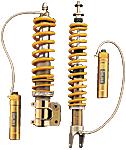 |
How the shock works
|
At low shaft speeds the damping
oil is forced through an adjustable bleed valve in the main
piston. The valve affects mainly rebound damping and has only
a small effect on compression damping, see below.
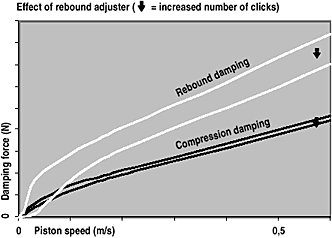
The adjuster is connected to the valve via an aluminium shaft,
which runs inside the piston shaft. When the temperature in
the shock increases the aluminium shaft extends, thereby closing
the bleed valve gradually.
This diminishes the influence of the oil viscosity changes due
to temperature, keeping the flow through the valve virtually
the same, regardless of temperature.
With the second adjustable bleed valve, on the top of the reservoir,
you can adjust the compression damping.
The valve restricts the flow to the reservoir but not from it,
thereby only influencing the compression damping, see below.
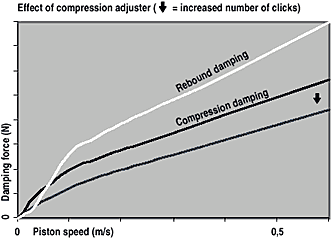
At higher shaft speeds the damping forces are primarily controlled
by the main piston and its compression- and rebound shim stacks.
By changing the number, diameter, and thickness of the shims
in the stack and by using different jets in the valves, your
Íhlins shock absorbers are tailor-made for your car. |
| |
When you are driving
|
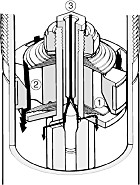
1. The oil
flow in the shock absorber body andů |
On a smooth
road
When you are driving on a smooth road and the shock absorbers
are compressed slowly (low shaft speed), the damping oil is
forced only through the adjuster valve in the piston shaft,
fig 1, flow 3.
The oil displaced by the piston shaft is forced through the
independent compression damping adjuster out into the external
reservoir, fig 2, flow 3. |
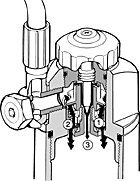
2. In the
reservoir during a compression stroke. |
The floating
piston in the reservoir is forced to move, compressing the gas
behind it.
When the shock absorber extends, the pressure behind the floating
piston will force the oil through a one-way valve, and back
into the shock absorber body, fig 3, flow 1 and 2.
The oil beneath the piston returns through the adjuster valve
in the piston shaft, fig 4, flow 3. |
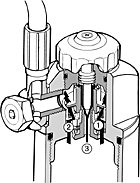
3. The oil
flow in the reservoir and... |
Hitting a
big bump
When you are hitting a big bump the shock absorbers are compressed
fast (high shaft speed). The oil can not be forced " fast enough"
through just the valve in the piston shaft. The pressure on
the compression side increases and opens the shim stack covering
the compression orifices in the piston, fig 1, flow 2.
Also, oil displaced by the piston shaft can not be forced through
just the valve in the reservoir. The pressure increases and
a shim stack, parallel to the valve, opens, fig 2, flow 1
and 2. |
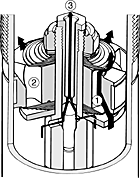
4. In the
shock absorber body during a rebound stroke. |
The floating
piston is forced to move, compressing the gas. When the shock
absorber extends, the floating piston will force the oil through
the one-way valve back into the shock absorber body, fig
3, flow 1 and 2.
The pressure difference over the piston is still high and the
flow can not be forced through just the valve in the piston
shaft. The shim stack covering the rebound orifices in the piston
opens and the oil returns, fig 4, flow 1. |
| |
External Adjusters
|
The Íhlins 46HRC shock absorbers
have the low speed compression adjustment knob located on top
of the reservoir, both on McPherson front struts and on traditional
shock absorbers.
A low speed rebound adjuster is located in the bottom end of
the McPherson front strut. Adjustments are made with a 3 mm
Allen key.
On traditional shock absorbers, the rebound adjustment knob
is located at the upper end of the piston shaft.
All the adjusters have a normal right-hand thread. Click position
zero (0) is when the adjusters are turned clockwise to fully
closed, and then opened to the first click.
Some models of the Íhlins Racing shock absorbers features camber
bushings that enable you to alter the front wheel camber. Depending
on how you mount the bushings, with the eccentric hole facing
the wheel or away from the wheel, different camber angles can
be obtained
Making adjustments
Suspension settings are dependent on your car's weight, your
driving style, track conditions etc. If you are not happy with
our recommended settings, here are a few guidelines and ground
rules how to make adjustments.
To make improvements, it is important to understand the function
of the shock absorbers and through testing learn how they affect
the handling of your car.
When making adjustments, always start with the Íhlins recommended
settings. Keep notes, make adjustments one at a time... and
in small steps.
The adjusters should normally not be adjusted in steps of more
than 2 clicks at a time and not outside the usable click range.
When you think you have made an improvement, go back to what
you started with and double check to be sure. Pay attention
to changes in conditions like tires, temperatures, etc.
In general, compression damping changes should be used to influence
the car's stability and response, while rebound damping changes
should be used to influence comfort and traction.
When you need more damping force, you should mainly try to increase
compression damping and use as little rebound damping as possible.
This usually means that you gain comfort and handling performance. |
|
